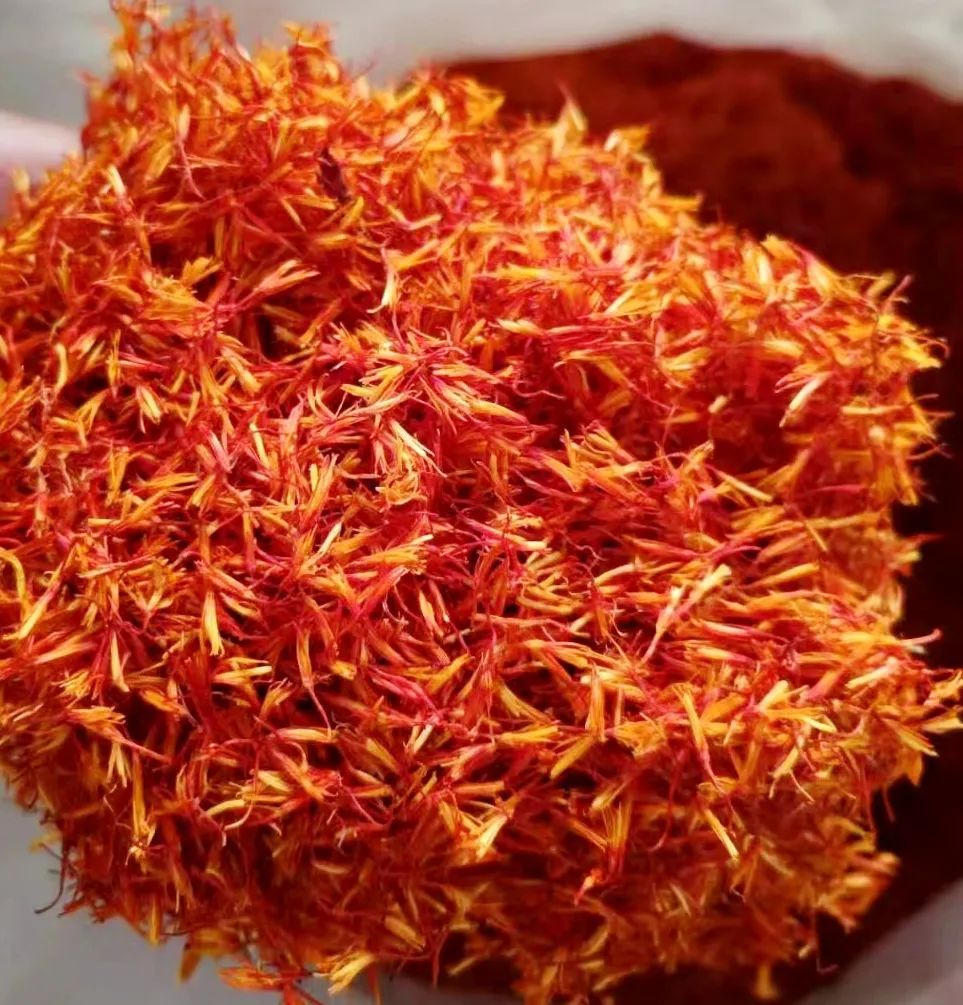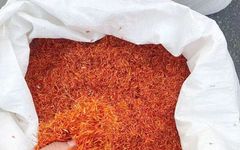

Safflower, also known as Honghua (Carthamus tinctorius), belongs to the Asteraceae family. The dried tubular flowers are orange-red, with narrow flower tubes that are 5-lobed at the tip. The lobes are linear, and the yellow anthers are fused into a tube that extends beyond the lobes, with a central stigma protruding. It has a distinctive fragrance and a slightly bitter taste. The best quality is characterized by long petals, bright red color, and soft texture.
In addition to its medicinal uses, safflower is also an excellent oilseed crop, with unsaturated linoleic acid content ranging from 73% to 85%, which has good preventive effects against cardiovascular diseases. Safflower also contains a large amount of natural red and yellow pigments, making it an important raw material for extracting dyes, food colorants, and cosmetic formulations.


Properties and Channels:
The taste is pungent, and the nature is warm. It enters the Heart and Liver meridians.
Functions and Efficacy:
It invigorates blood circulation, regulates menstruation, disperses blood stasis, and alleviates pain.
Clinical Applications:
It is beneficial for treating amenorrhea, dysmenorrhea, retained lochia, chest pain due to blood stasis, abdominal pain due to stasis, stabbing pain in the chest and hypochondrium, traumatic injuries, and swelling and pain from sores.
Precautions:
It has the effects of invigorating blood circulation and dispersing stasis, and should be avoided by pregnant women as it may cause miscarriage.  Originally from Central Asia, it is found wild in the Soviet Union and cultivated in Japan and Korea. In China, it is cultivated in Henan, Xinjiang, Gansu, Shandong, Zhejiang, Sichuan, and Tibet. In addition to these regions, wild safflower can also be found in Shanxi, Gansu, and Sichuan.
Originally from Central Asia, it is found wild in the Soviet Union and cultivated in Japan and Korea. In China, it is cultivated in Henan, Xinjiang, Gansu, Shandong, Zhejiang, Sichuan, and Tibet. In addition to these regions, wild safflower can also be found in Shanxi, Gansu, and Sichuan. 
Safflower is an annual herb, growing to a height of 50 to 100 (150) cm. The stems are erect, branched in the upper part, and are white or pale white, smooth, and hairless. The lower leaves are lanceolate, oblanceolate, or long oval, measuring 7-15 cm in length and 2.5-6 cm in width, with margins that are coarsely serrated, finely serrated, or entire. The upper leaves are gradually smaller and lanceolate with serrated edges, and the tips have spines that are 1-1.5 mm long. All leaves are hard, leathery, hairless, and glossy, with no petiole at the base, clasping the stem.
The flower heads are numerous, arranged in a corymb at the top of the stems, surrounded by bracts that are oval or ovate-lanceolate, with spines at the tips measuring 2.5-3 cm long. The outer bracts are green, with or without spines, and the inner bracts are hard and membranous, ovate-lanceolate to long ovate, up to 2.3 cm long, with pointed tips. The small flowers are red or orange-red, all bisexual, with a corolla length of 2.8 cm, and the tubular part is 2 cm long, with lobes reaching the base of the corolla.
The achenes are inversely ovate, measuring 5.5 mm long and 5 mm wide, white, with 4 ridges, and the ridges extend at the top of the fruit. They have no pappus. The flowering and fruiting period is from May to August.


It is suitable for planting in well-drained, moderately fertile sandy soils, with oil sand and purple sandy soils being the most suitable. The seeds germinate easily, sprouting at temperatures above 5°C, with an optimal germination temperature of 15-25°C.
Water Requirements:
Safflower has a well-developed root system that can absorb moisture from deep soil layers. Excessive humidity in the air or soil can lead to various diseases. During the seedling stage, brief waterlogging at temperatures below 15°C will not cause seedling death; however, in high-temperature seasons, even short-term waterlogging can lead to safflower death. Rain during the flowering period can adversely affect pollen development. Continuous rainy weather during the fruit maturation stage can cause seed germination, affecting seed and oil yield.
Safflower prefers warm, dry climates, is cold-resistant, and can tolerate poor soil. Although safflower is drought-resistant, moderate irrigation in arid climates is necessary for high yields.
Temperature Requirements:
Safflower has a wide temperature adaptability, germinating and growing within a range of 4-35°C. The optimal temperature for seed germination is 25-30°C, while the optimal growth temperature is 20-25°C. If the flowering period encounters low temperatures around 10°C, the floral organs may develop poorly, and in severe cases, the flower heads may not open normally, and the opened flowers may not set seed. The germination rate is about 80%. It has strong adaptability, with a life cycle of 120 days.
Light Requirements:
Safflower is a long-day plant, and the length of daylight affects both the duration of the rosette stage and, more importantly, its flowering and fruiting. Adequate light conditions promote good development and full seed filling.
Nutritional Requirements:
Safflower can grow in soils with varying fertility, and proper fertilization is one of the measures to achieve high yields. Sufficient soil fertility and comprehensive nutrient content lead to higher yields.
Soil Requirements:
Although safflower can grow in various soil types, it thrives best in deep, well-drained, fertile neutral loam.


